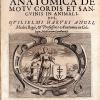'William Harvey and the Circulation of Blood' RCP/Wellcome Video
Commentary
In 1928, the Royal College of Physicians used the new medium of film to produce an educational video illustrating the key stages of Harvey's work with animated diagrams and footage of key dissections and experiments.
1928 Version. First undertaken in 1928 on the 300th anniversary of the publication of De motu cordis, the video did not have animation or sound. This original version, available online at British Pathé, was designed by Sir Thomas Lewis, a leading British cardiologist (1881-1945) and Sir Henry Hallett Dale, Nobel-prize winning physiologist and pharmacologist (1875-1968). The film is not for the faint-hearted, featuring graphic footage of vivisected frogs, snakes and dogs, and of a boy who seems to suffer from tachycardia (abnormally fast heartbeats). It is in many ways a historical document of the interwar expressionistic sensibility. Tellingly, the anonymous person undertaking the in-detail description of the film was appalled by some of the footage and expressed his/her reactions to it: 'pretty gory and revolting', 'disgusting C[lose]/U[p]!' The verdict is given in the short summary: 'Gruesome medical film about how blood circulates - not for the squeamish.' An interesting aspect of the film is that the individuals undertaking the reconstruction of experiments are in some sense actors posing as Harvey: see their 'early modern' sleeves (particularly at 0:55, 12:40, 14:15, 16:32 or 30:15 onwards). Length: 30:48 minutes.
1957 Version. The film was radically reworked in 1957; the new version is available at the Wellcome Collection. This is a film with colour, sound and animation that is introduced by Henry H. Dale himself (Lewis had passed away of heart disease by then). The reconstruction of the experiments is done by Dr Michael de Burgh Daly and Dr Leonard Godwin. Although Dale seems to suggest that the reworked version was solely done to benefit from new technical advances, it seems that postwar sensibility may have played a part in the decision to redo it. The images clearly identifying vivisected animals are removed with the new footage being more generic. It is still a graphic film; notably, there is footage of a man suffering from an aneurysm at 15:50. Length: 34:03 minutes.
1972 Version. The film was further refreshed in 1971-72 and is available at the Wellcome Collection (38:30 minutes). It featured more updated research and additional reworking of Harvey's experiments. The rather gruesome footage of the aneurysm is removed. This latest version still looks rather dated in presentation, but its content is that of an educational classic, 'highly recommended' by Dr. W.F. Bynum (Wellcome Institute for the History of Medicine) 'as ...one of the best films ever produced on the history of medicine...'
1978 Version. This is a shortened version of the 1972 film. You can view it here. We have added subtitles so you can follow Harvey's arguments, and in the Description you will find a guide to where the quotations from Harvey come from. The video can profitably be slowed down to 0.75 of the speed. Length: 27:34 minutes.
Credit for video commentary: Georgiana D. Hedesan (October 2021)

